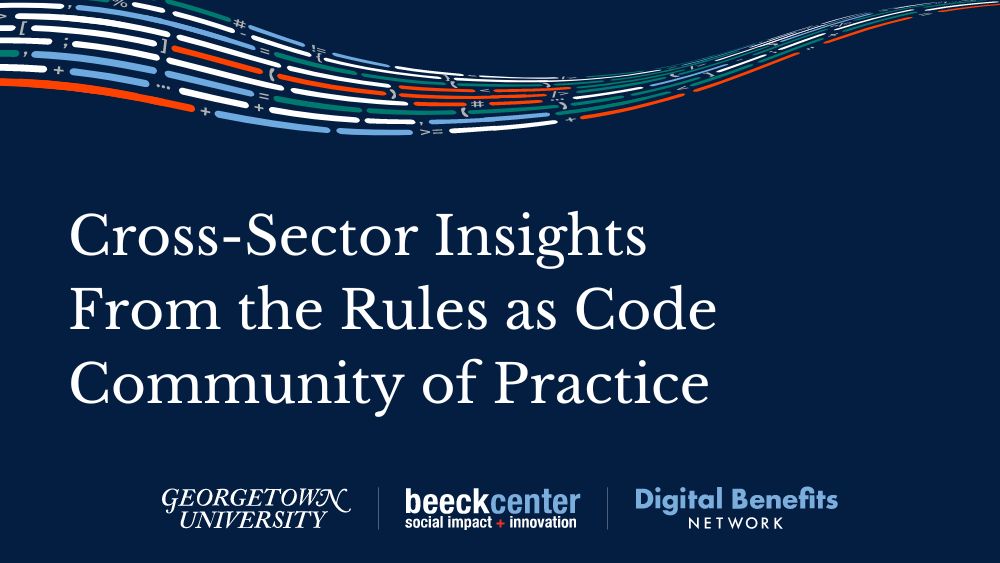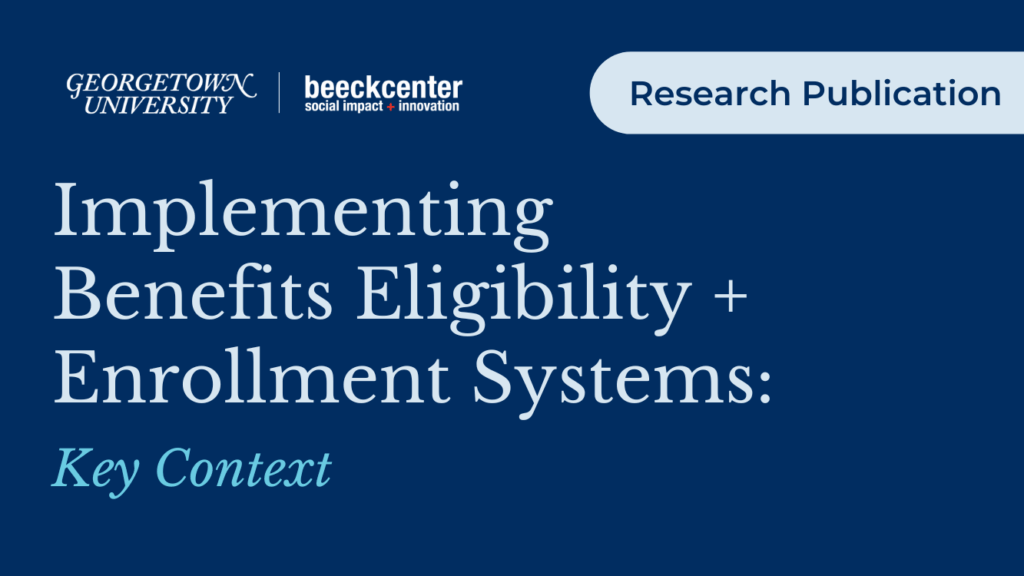Cross-Sector Insights From the Rules as Code Community of Practice
In this report, the Digital Benefits Network shares learnings from the Rules as Code Community of Practice. Insights are grouped along core themes expressed by cross-sector practitioners, including complexity in policies, interest in sharing knowledge, tools, and code, the need for more training and technical assistance, and willingness to collaborate on an open standard for writing rules and developing a shared code library.

In 2023, the Digital Benefits Network deepened our engagement with cross-sector practitioners working on benefits eligibility policy, digital systems, rules implementation, and analysis.
We launched our Rules as Code Community of Practice through a series of roundtables with grassroots practitioners (April 2023) and government practitioners at federal, state, local, tribal, and territorial (SLTT) agencies (September 2023). Additionally, we conducted a survey with grassroots practitioners and a meeting poll with government practitioners to better understand current aspirations, challenges, and needs related to implementing Rules as Code.
As we continue to mature this community of practice, we are excited to share learnings from these touchpoints, and have grouped insights along core themes expressed by practitioners. We believe the path forward for Rules as Code requires participation across sectors, to leverage the experience and expertise of multi-disciplinary practitioners.
Grassroots practitioners are non-governmental practitioners from both nonprofit and private sector organizations that are working on benefits eligibility and enrollment. Many work closely with government or on behalf of government. Many have been making technical advances in how rules are communicated, stored, and implemented through utilizing Rules as Code approaches in their products, like eligibility screeners, enrollment assistance tools, and policy analysis tools. SLTT governments are responsible for most public benefits delivery and systems development. SLTT governments are also able to develop some of their own rules and policies within specific programs, or may have non-federally funded public benefit programs for which they can develop rules. So far we have primarily engaged state, county, and municipal government practitioners, although we seek to include tribal and territorial practitioners in the community of practice. Federal government sets overarching public benefits policy and laws, and provides guidance, and often funding, for SLTT systems. We have engaged practitioners from the executive branch, including practitioners at leadership offices and agencies administering programs, as well as the legislative branch.
Key Insights
- The complexities in policy across programs and jurisdictions create challenges for both teams implementing policy into technology systems and people seeking benefits.
- There is strong interest in sharing knowledge, tools, and code across organizations.
- Benefits administrators and policymakers need more training and technical assistance to understand and champion Rules as Code as an approach to digitizing policy.
- There is willingness to collaborate on an open standard for writing rules and developing a shared code library.
Policy
Complexity and Variation
A common challenge across sectors is the differences in policies across jurisdictions. Grassroots practitioners, who create tools that work in many places, are challenged with managing the variations in policy across states and regions within states. SLTT practitioners rated federal and SLTT policy change as top factors in eligibility rules modernization. SLTT practitioners shared about navigating between municipal, state, and federal policies and the inherent challenges of maintaining rules at different levels with minimal communication points and no data-sharing agreements. One state’s legislature commissioned a report asking departments to improve service and experience—one main finding was that the policies are hard to access, search, and reconcile, with different policymaking processes in each agency. For example, one agency may issue memos, and another directives. As that state is county-administered, county workers must then do a significant amount of manual work to figure out what policies apply to their cases. A federal practitioner inquired how to build flexibility into the rules as they are written at the federal level, and how to ensure that you allow for states with unique situations.
Similarly, SLTT practitioners shared that residents are challenged by the policy complexity. They are concerned that residents have a hard time figuring out what they are eligible for, and then do not apply because the “learning and compliance costs are too high,” thus limiting residents’ “ability to gain access to life-saving services.” One practitioner suggested it would be important to “take the guesswork out of the resident’s hands and move it back to the government’s responsibility.”
Relational Service Delivery
Practitioners from all sectors expressed a desire to ensure the human and relational elements of benefits delivery are maintained, even as agencies and government decision makers explore opportunities to streamline and standardize how policy rules are digitized. One SLTT practitioner highlighted how caseworkers use relationships and knowledge to help people get support. They wondered if Rules as Code could optimize bad policy that is designed to keep people from receiving benefits. Similarly, a grassroots practitioner highlighted potential equity implications of further automation, and how to account for the “fuzziness” of rules that can be interpreted to help people receive benefits. This practitioner asked a foundational question: “Can we develop standards to facilitate automation while also keeping human discretion in the loop?” As a potential benefit from a Rules as Code approach, another SLTT practitioner suggested that better rules digitization—and using it to improve service design— can help provide workers with more time to serve people.
Tools
Digital Systems for Eligibility and Enrollment
SLTT practitioners represent agencies whose digital systems are at different maturity levels. Some agencies are looking to make changes across many legacy backend systems, while others are starting to modernize their public-facing applications and forms. Other agencies are using lightweight tools for eligibility screening that are managed through spreadsheets and web content management systems, with others using business rules engines and incorporating API capabilities.
Many SLTT practitioners expressed challenges with their eligibility and enrollment systems and how they intersect with policy. Updating the code when rules change is a pain point that was shared by many SLTT practitioners, in part because programs and systems are siloed across agencies, and every program has a different way to store and track eligibility rules. Some program administering agencies also do not control their systems directly and, instead, their systems are managed by a government technology agency. One practitioner described it as “a scramble” to update the code in legacy systems. Another practitioner shared that the urgency to make changes in systems often stands in the way of bringing a coalition together to find a different approach. Grassroots practitioners also find that few governments provide notifications of rule changes, so they have to track updates on their own, duplicating work and risking inaccuracy in the rules.
Tools to Navigate Complexity and Improve Service Delivery
Many SLTT practitioners are creating tools to help them work through policy complexity and streamline service delivery. One practitioner shared on how they are defining what information to collect versus not collect, and what information can be used as proxies. Another practitioner shared that their state’s internal eligibility matrix shows which programs have overlapping rules or areas that could have overlap. They are identifying places where agency change could simplify policy and remove overlaps. One practitioner sees Rules as Code as an opportunity to support their “no wrong door” vision so that eligibility is the same quality across any pathway, or door, into services.
Improving Systems
SLTT practitioners shared ideas on how to improve the current tools, including having a more graphical interface for reviewing and updating the rules. Several municipalities and states are collaborating on an open source tool (Civiform) that allows them to benefit from each other’s product features under a shared governance model.
Grassroots practitioners are confident in the tools and systems they are building, but desire more shared tools for writing, storing, and implementing eligibility rules. One practitioner encouraged the field to not overcomplicate the technical solution by jumping to a business rules engine. However, others underscored the need to create tooling that can compete with existing rules engine software. One practitioner noted that current rules engine software is often closed and expensive or open and under-developed. They encouraged the community to look at how business intelligence tools ingest rules data and what would be needed to integrate with APIs.
Paths Forward
Leadership
Across sectors, there is a need for leadership and shared understanding of the possibilities of Rules as Code. SLTT practitioners rated leadership buy-in as a top factor for eligibility rules modernization. Grassroots practitioners expressed that current rulemakers have limited understanding of Rules as Code, and there is a need for more implementation and adoption case studies. They suggested that there could be a federal mandate, grant money, or guidance on using eligibility rules as code, perhaps tied to advancing artificial intelligence and large language models. A federal practitioner shared that there are challenges around trust—rather than solely technical challenges—between levels of government, and questioned if states trust the federal government and agencies to provide leadership and rules information.
Open, Standardized Information
Grassroots practitioners shared pain points in the current piecemeal state of documentation and communication of rules. One practitioner expressed wanting to see governments provide “real understanding and transparency to public benefits recipients.”
Cross-sector practitioners expressed that the lack of adopted standards presents challenges and expressed a need for common standards to communicate rules. A federal practitioner shared that their team has been exploring possible standards for rules notation by reviewing what others are doing and working in an iterative way to test and learn, but that they need more support to know which paths to pursue. Grassroots practitioners expressed that the standards would ideally be developed in the open, and funded in a way that allows for pooling of resources across organizations. They encouraged government agencies to use the necessary political capital to research, adopt, and/or require a standard for eligibility rules.
With a standard developed, grassroots practitioners aspire to have all program rules, across jurisdictions, in a single, open source project. Ideally it would use common code libraries and also have a shared data dictionary. Additionally, it would provide a way for non-developers to understand the code, such as visual flow charts or low-code tools. They also see the need for recommendations on how to implement Rules as Code, including considerations for accessibility and user experience, as well as training and support to encourage adoption of the library by local, state, and federal governments for benefits determinations. As the work matures, they also expressed a need for providing an API standard for importing and exporting data.
Additionally, grassroots practitioners expressed interest in having a set of standardized eligibility questions to help people apply for multiple, related benefits. Tools to help validate code, such as test cases and worksheets used by frontline staff for eligibility, have been raised across sectors.
Community
Across the sectors we engaged, practitioners reported finding value in learning from others, sharing about their projects, and discussing bigger foundational questions about benefits eligibility and service delivery. Grassroots practitioners expressed a strong desire to have an expert community to learn together, share prototypes and pilots, and ultimately co-create open source tools and standards together. Grassroots practitioners also welcome expertise from across domains including health information exchange and human services referral providers. SLTT practitioners are eager to bring information learned in community back to their work to inform how to store, track, and communicate rules. They expressed that this is an important message to elevate to their agency leadership and staff. Federal practitioners shared that they appreciate hearing first hand accounts of successes and failures and meeting other people across government working on similar issues.
Join Us
The DBN welcomes interested cross-sector practitioners to join our Rules as Code Community of Practice. We are building on these insights to support ongoing community dialogue, research, events, and prototyping.
Citation
Cite as: Ariel Kennan and Tina Amper. “Cross-Sector Insights From the Rules as Code Community of Practice”, Digital Benefits Network, February 6, 2024.
Cross-Sector Insights From the Rules as Code Community of Practice


